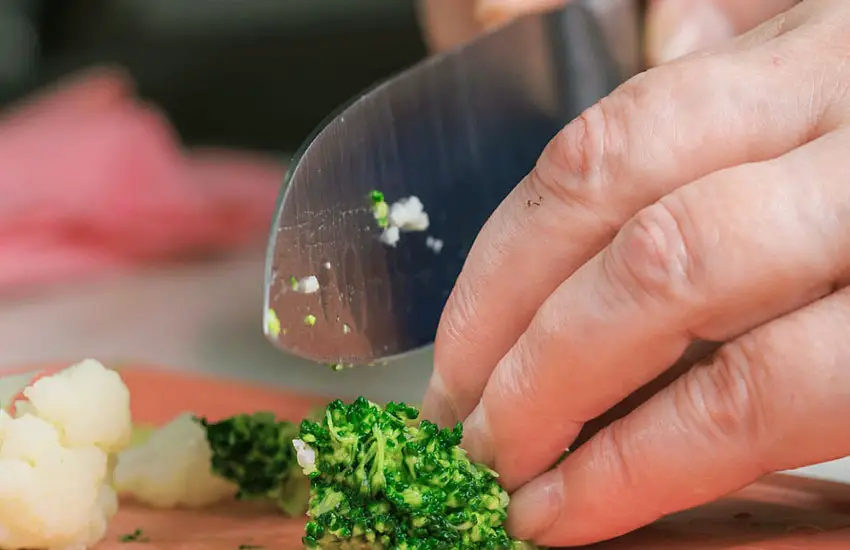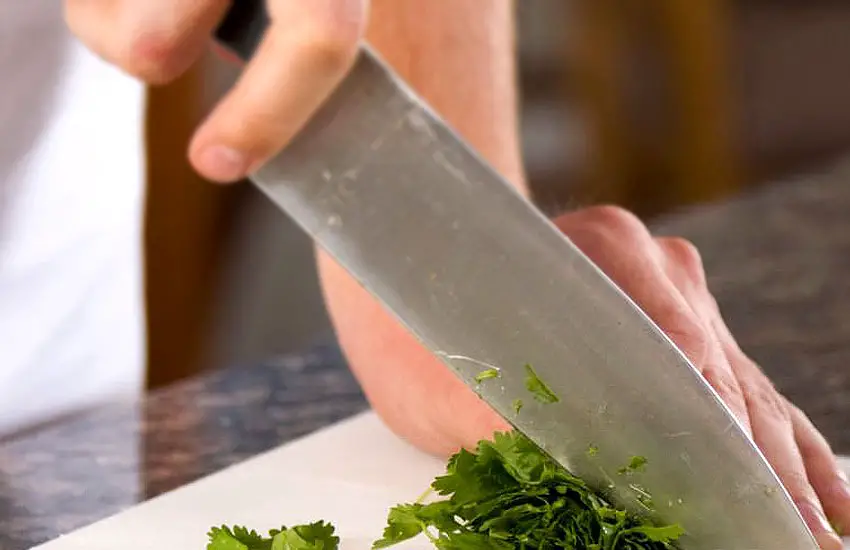As an Amazon Associate, I earn from qualifying purchases at no extra cost to you.
How to Use a Chef’s Knife Like a Pro: Expert Tips and Techniques
Are you looking to enhance your culinary skills? One essential tool that every aspiring chef should have is a chef knife. This versatile tool is a must-have in the kitchen, allowing you to tackle a wide range of chopping, slicing, and dicing tasks with precision and ease. In this guide, we will show you how to use a chef knife effectively and efficiently, helping you to become a master in the kitchen. So, let’s dive in and discover the art of using a chef’s knife like a pro!

Choosing The Right Chef’s Knife
Choosing the right chef’s knife is crucial for any cook or chef, as it’s arguably the most important tool in the kitchen. Here are some factors to consider when selecting a chef’s knife:
Consider The Different Types Of Chef’s Knives
Chef’s knives come in different types, each designed for specific purposes. The most common types are the French, German, and Japanese knives. French knives are versatile and well-suited for a variety of tasks, while German knives are more robust and ideal for heavy-duty cutting. Japanese knives, on the other hand, are renowned for their precision and sharpness. Consider the type of cooking you do and the tasks you perform most frequently when choosing the right chef’s knife for your needs.
Look For A Knife With The Right Weight And Balance
The weight and balance of a chef’s knife are crucial factors to consider. A well-balanced knife ensures greater control and precision when cutting, chopping, and slicing. The weight of the knife should feel comfortable in your hand, allowing for easy maneuverability without causing fatigue. Test the weight and balance of different knives to find the one that feels the most natural and comfortable for you.
Pay Attention To The Handle
The handle of a chef’s knife can greatly impact your overall experience and comfort when using it. Look for a handle that provides a comfortable grip and ergonomic design, allowing for extended use without causing strain or discomfort. Consider the material of the handle, such as wood, plastic, or metal, and choose a handle that feels secure and comfortable in your hand.
Understanding Knife Safety And Handling
Using a chef’s knife may seem simple, but it actually requires proper technique and caution to ensure your safety while slicing and dicing. By understanding knife safety and handling, you can avoid accidents and make the most out of this essential kitchen tool.
Hold The Knife Correctly
When using a chef’s knife, the way you hold it can significantly impact your control and safety. Follow these steps to hold your knife correctly:
- Place your thumb against the side of the blade, near the handle.
- Wrap your fingers securely around the handle, ensuring a firm grip.
- Position your index finger on the spine of the knife for extra control.
By holding the knife this way, you maintain stability and reduce the risk of accidental slips that can lead to injuries.
Practice Proper Slicing And Dicing Techniques
Slicing and dicing with a chef’s knife requires precision and skill. Follow these techniques to ensure efficient and safe cutting:
- Place the food item on a stable cutting board, securing it with your non-dominant hand.
- Using a fluid motion, guide the knife through the food, keeping your fingers curled and away from the blade.
- Maintain a consistent rhythm and apply even pressure to achieve uniform cuts.
- Avoid the temptation to rush, as this can lead to loss of control.
Practicing these slicing and dicing techniques will result in consistent, professional-looking cuts and decrease the risk of accidents.
Avoid Common Mistakes That Can Lead To Accidents
Being aware of common mistakes is crucial to prevent accidents in the kitchen. Stay safe by avoiding the following errors:
- Using a dull knife: Dull knives require more force to cut through food, increasing the likelihood of slips and injuries. Keep your knife sharp by regularly honing or sharpening it.
- Improper chopping surface: Avoid using unstable or slippery cutting surfaces that can cause your knife to slip.
- Poor hand positioning: Always keep your fingers curled under and away from the blade to minimize the risk of accidental cuts.
- Uncontrolled knife motion: Reckless movements while using a knife can result in accidents. Always maintain steady control and focus.
By steering clear of these common mistakes, you can ensure a safe and enjoyable cooking experience with your chef’s knife.
Basic Cutting Techniques
Mastering basic cutting techniques is essential for any aspiring chef. Whether you’re a culinary enthusiast or simply want to improve your kitchen skills, understanding how to properly wield a chef’s knife can make a world of difference in your cooking. In this section, we’ll explore three of the most fundamental cutting techniques: the rock chop technique, the julienne technique, and the chiffonade technique.

The Rock Chop Technique
The rock chop technique is the foundation of most cutting movements with a chef’s knife. This technique involves using a gentle rocking motion to effortlessly slice through ingredients. To execute the rock chop technique effectively, follow these steps:
- Ensure your chef’s knife is sharp to minimize resistance and ensure smooth cutting.
- Hold the knife handle firmly with your dominant hand and grasp the food to be chopped with your non-dominant hand.
- Place the tip of the knife blade on the cutting board and elevate the handle at an angle.
By positioning the knife in this way, you create a large and stable cutting surface. Begin rocking the knife back and forth while guiding it smoothly through the ingredients using a pivoting motion of your wrist. Practice this technique to achieve efficient and consistent results.
The Julienne Technique
The julienne technique is a precision cutting method used to create long, thin strips of ingredients. Whether you’re preparing colorful bell peppers for a stir-fry or carrots for a salad, the julienne technique adds both visual appeal and uniformity to your dishes. Here’s how you can master the Julienne technique:
- Begin by trimming the ends of the ingredient to create a stable base.
- Cut the ingredients into evenly sized rectangular or square planks.
- Stack a few planks together and slice them lengthwise into thin, matchstick-like strips.
Remember to prioritize safety while using this technique by keeping your fingers curled and using a steady, controlled motion. With practice, you’ll be able to julienne vegetables like a pro!
The Chiffonade Technique
The chiffonade technique is perfect for creating delicate, ribbon-like strips of leafy greens, such as basil or mint. These elegant strips can be used as garnishes or incorporated into salads and pasta dishes. To master the chiffonade technique, follow these steps:
- Start by stacking the leaves on top of each other, ensuring they are neatly aligned.
- Roll the stacked leaves tightly into a cigar-like shape.
- Using a sharp chef’s knife, cut across the rolled leaves perpendicularly, creating thin ribbons.
Take your time and maintain a steady cutting motion, so you achieve consistent thickness throughout the chiffonade. With a little practice, you’ll be able to add a touch of elegance to your dishes with this technique.
Sharpening And Maintaining Your Chef’s Knife
When it comes to honing your chef’s knife, sharpening, and proper maintenance, it’s essential to utilize the correct tools and techniques to preserve the blade’s edge and extend its longevity. By investing time in sharpening and maintaining your chef’s knife, you can ensure precision and efficiency in the kitchen.
Using A Honing Rod To Maintain The Knife’s Edge
Regular use of a honing rod is crucial for maintaining the sharpness of your chef’s knife. When the blade starts to feel dull, using a honing rod can help realign the edge, keeping it sharp and ready for use. It’s important to hold the knife at a 20-degree angle and make several gentle strokes on each side of the blade to maintain its sharpness.
Investing In A Quality Whetstone For Sharpening
For more intensive sharpening, investing in a quality whetstone is essential. Whetstones come in various grits, which allow you to sharpen and refine the blade to your desired level of sharpness. It’s advisable to soak the whetstone in water for about 10-15 minutes before use. Then, holding the knife at the correct angle, utilize smooth and consistent strokes to refine the blade’s edge.
Proper Care And Storage Of Your Chef’s Knife
Ensuring the proper care and storage of your chef’s knife is essential to maintain its sharpness and longevity. Always hand wash and dry the knife immediately after use to prevent corrosion. Storing the knife in a knife block or on a magnetic strip helps prevent damage to the edge. Additionally, avoid storing knives in a cluttered drawer to prevent dulling or chipping of the blade.
Final Words
Mastering the use of a chef’s knife is essential for anyone serious about cooking. The correct grip, cutting techniques, and maintenance are crucial to maximizing its potential. With practice and patience, you can enhance your culinary skills and enjoy the satisfaction of effortless, precise cutting.
Incorporate these tips into your kitchen routine to elevate your cooking experience.
